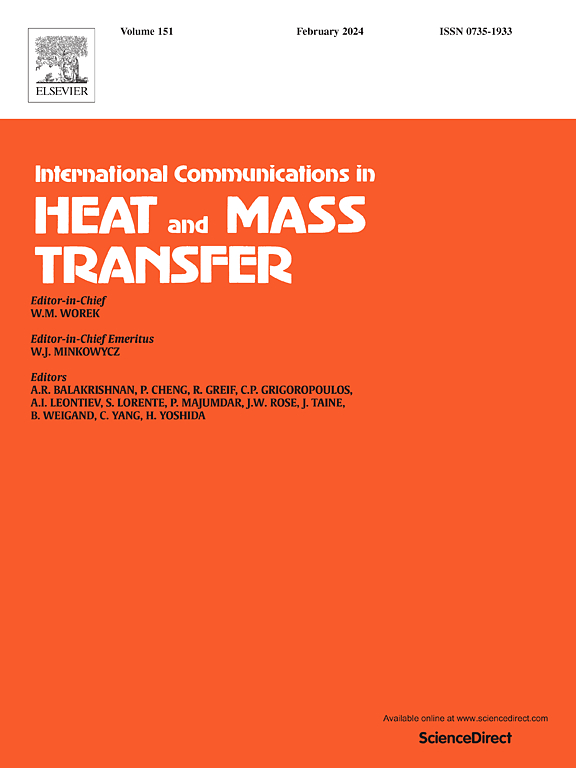Effect of geometric asymmetry on thermal performance in non-coaxial L-shape oscillating heat pipe
IF 6.4
2区 工程技术
Q1 MECHANICS
International Communications in Heat and Mass Transfer
Pub Date : 2025-03-24
DOI:10.1016/j.icheatmasstransfer.2025.108821
引用次数: 0
Abstract
The paper investigates the performance of a novel oscillating heat pipe with a unique L-shaped geometry, where the evaporator is oriented at a 90° angle to the condenser. The experiment explores the influence of gravitational acceleration by adjusting the inclination angle of the system across a full range from 0° to 180°, using acetone as the working fluid. The capillary tube has an inner diameter of 1.5 mm, allowing the formation of liquid plugs and vapor bubbles. Three filling ratios were evaluated: 50 %, 70 %, and 80 %, with a maximum applied heat flux of 43 kW m−2. Under optimal conditions, the thermal resistance was found to be 0.48 K W−1. The findings indicate that the geometric design and orientation relative to the gravitational field of Earth have a significant impact on the thermal performance of the oscillating heat pipe. Although the device has relatively few bends, it achieved efficient horizontal heat transfer under certain conditions. In particular, these results, particularly for high filling ratios, have not been reported in previous studies. In addition, the research improves the analysis of oscillating heat pipes, with thermal resistance trends providing valuable insights into start-up behavior, overheating risk, and different operating modes.
求助全文
约1分钟内获得全文
求助全文
来源期刊
CiteScore
11.00
自引率
10.00%
发文量
648
审稿时长
32 days
期刊介绍:
International Communications in Heat and Mass Transfer serves as a world forum for the rapid dissemination of new ideas, new measurement techniques, preliminary findings of ongoing investigations, discussions, and criticisms in the field of heat and mass transfer. Two types of manuscript will be considered for publication: communications (short reports of new work or discussions of work which has already been published) and summaries (abstracts of reports, theses or manuscripts which are too long for publication in full). Together with its companion publication, International Journal of Heat and Mass Transfer, with which it shares the same Board of Editors, this journal is read by research workers and engineers throughout the world.

 求助内容:
求助内容: 应助结果提醒方式:
应助结果提醒方式:


